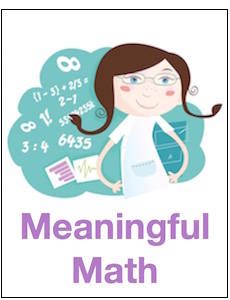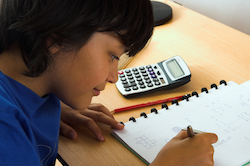Math: The Pros & Cons of Productive Struggle

This phrase has recently appeared on the growing list of educational buzzwords that are part of our professional lives these days.
Although I am personally convinced that productive struggle is a necessary component for student growth, I am less sure of how to successfully implement it my own classroom.
So the thought of how to help my students engage in productive struggle has been on my mind all summer. I started by researching the origins of the phrase, which can be defined as “students expend(ing) effort to make sense of mathematics, to figure something out that is not immediately apparent” (Hiebert and Grouws, 2007).

When it comes to productive struggle, there are so many questions to address. A few that come to mind are:
- How much guidance should the teacher provide?
- What “hints” if any should be given to students?
- What type of work motivates students to engage in productive struggle?
- How do you insure that the struggle is productive and not merely frustrating?
These are questions I will continue to work on as the new school year unfolds. In the meantime, I’d like to invite you to engage in some discussion here. Let me start by sharing a recent personal experience I had as a student engaged in productive struggle.
Struggle, from the student point of view
When I attended several math workshops this summer, basically as a “student,” the idea of productive struggle was very much on my mind. In one workshop, we essentially worked various math problems with a partner, without direct instruction from our teacher.
This chance to put on the hat of a student learner is one of the best things that’s happened to me as an educator. The opportunity to struggle as I tried to figure things out provided some needed perspective on both the value of productive struggle and the potential pitfalls.
First, the positives

As the workshops progressed, I enjoyed the challenge of solving problems that I didn’t know the answer to ahead of time (the situation our students are usually in). It was fun!
I know it’s unrealistic to think that students will always enjoy the activities we plan for them, but I do think that allowing students to engage in more frequent productive struggle can result in satisfaction, and even fun for some students, if properly scaffolded (which is another conversation).
I remember so much from the activities I worked on, especially the ones that were difficult for me. As a teacher, the “sticky learning” that resulted from working hard to find a solution made a big impression on me. Sometimes I get discouraged when students struggle, but I need to rethink that. So long as we’re supported and find our way through the challenge, struggle has some real benefits.
But there are potential pitfalls
I enjoyed my time as a student and the opportunity to engage in productive struggle. However, I can also attest to the frustration, irritation, and even embarrassment that was sometimes a by-product.
There were times when I did not feel like I had an entry point to begin working on a problem, and I couldn’t even think how to ask a good question. (Working with a partner helped – sometimes just a peek at their work was all I needed.)
Other times, I would be asked a question and find it difficult to put the answer into words. Sometimes it took me longer than one class to grasp a certain concept, and it might even be the next day before I fully understood it.
On several occasions I would work a problem differently than others in the group and would be embarrassed to share what I did, afraid that I had done it the “wrong way.” And there were times I wasn’t sure about my work and I didn’t want my instructor looking at my paper.
Haven’t we all had this same experience with our students? Until this summer, I don’t think I fully understood how vulnerable you feel when someone looks at your paper and can see any and all of your shortcomings and mistakes.
I do realize that a trusting classroom culture is a big part of making students feel comfortable, but that only goes so far. My teachers this summer were truly nice people and did a great job of creating very positive classroom cultures, yet I still struggled with feelings of inadequacy at times.
My summer take-aways
This is what I learned from my experience as a student:
- Students can experience significant personal satisfaction from productive struggle. (I did!) That brand of satisfaction cannot be purchased in any other way.
Learning with a partner can take some of the frustration out of problem-solving while keeping the challenge (and the fun).
- Classroom culture is essential! I think empathy and respect help students work productively. It is vital to be respectful and sensitive to students’ feelings. I realized that I need to get to know my students even better, and I need to be aware that students have different comfort levels. (Note to self: spend more time at the beginning of the year getting acquainted).
- It’s okay if students make mistakes. Let them know that repeatedly. Making mistakes is simply part of the learning process. I made plenty this summer, and I learned more than I ever have.
- An activity is not automatically a failure if a student doesn’t finish in the time I have allotted. Time spent figuring things out is productive time.
- For productive struggle to be successful, students need to be given assignments that they are willing to “expend effort” on, as well as assignments that challenge them and stretch their thinking skills. At the same time, the assignment shouldn’t be so difficult that students become discouraged. Easy, right?
What have you noticed about “productive struggle” in your own classroom or professional learning experiences?
RESOURCES
► Hiebert, J., & Grouws, D. A. (2007). The effects of classroom mathematics teaching on students’ learning. In F. K. Lester (Ed.), Second handbook of research on mathematics teaching and learning (pp. 371–404).
► Harnessing the Power of the Productive Struggle (Ellie Cowen, Edutopia)
► Let Your Students Fail (Derek Pipkorn, Mathematics Teaching in the Middle School blog, National Council of Teachers of Mathematics)
► Productive Struggle – Part 2 (Andrew Stadel’s blog)
► Productive Struggle in Mathematics (Interactive STEM Research Brief, Education Development Center)
► The Role of Productive Struggle in Teaching and Learning Middle School Mathematics (Hiroko K. Warshauer)




































Thank you for sharing your experience and your thoughts about productive struggle in the classroom. I’d like to add to your ideas but you’ve identified the key issues so well, it’s hard to add more.. I think an area to further investigate is how to develop classroom cultures where students feel safe from ridicule, understand WHY struggle is part of math learning, develop confidence in sharing ideas, recognize that learning comes as much from mistakes as from correct work and value cooperative group/partner work. Students need to really understand what makes a learning community before they will be willing to share. I think often teachers spend too little time establishing routines and norms in the beginning of the year and then are stymied about why students are so dependent on the teacher and so resistant to struggling through what is challenging. Again, thanks for the words to get us thinking.
I definitely agree that initially putting more emphasis on the process than on the content so students to learn to work effectively as a community of learners will pay off during the rest of the year.
Thank you for your comment! I completely agree that we need to invest the time in the beginning of the year “establishing routines and norms.” In the past, I was so worried about “covering” the standards that I wouldn’t spend enough time in the beginning of the year laying the right foundation. I also really liked what you said about “learning coming from mistakes.” That can be a real shift for many students, and I think it is an idea that has to be reinforced throughout the year.
I find it helpful to give hints in the form of questions to model what students can learn to do to self-coach/guide themselves or a group. As they learn to ask themselves the same or similar questions their independence from the teacher can grow even further and give them more endurance to keep struggling toward a solution.
Thank you for your comment! I like the idea of hints in the form of questions. Also, I agree that students will grow more independent given time and practice.
Matt Larson, NCTM president, makes a point of looking at “productive struggle” from the point of the parent. Parents do not like to hear about struggle or failure. He also uses the phrase “expend effort to make sense of math.” Along with a classroom culture and helping students understand the benefits of working on a problem and learning from mistakes, teachers need to help parents understand this “growth mindset” as well.
Thank you for your comment! I think you are absolutely right; parents do need to be educated regarding productive struggle. I know from experience that parents can be concerned if they think their child’s teachers aren’t directly answering their questions. Educating parents ahead of time can prevent misunderstandings later. Thanks for bringing up such an important topic.
Thank you for a great piece on productive struggle. I think one way to know whether the struggle is productive or merely frustrating is to do the problem or task yourself and find the places where you think your students might struggle. With those places in mind, come up with some possible guiding questions to have at the ready.
Also, teaching your students about productive struggle and just how important it is to learning can be helpful in warding off “learned helplessness.” Share your experiences from this summer – everyone struggles, even the teacher!
Thank you for your comment! I agree with you, working a task ahead of time will help identify places students will struggle. Also, I really liked what you said about letting students know that everyone struggles. I think students are more willing to try if they realize that struggling and making mistakes is part of the process for everyone.
Hi Michelle,
As my colleagues will tell you, I rarely respond to a blog entry – mostly due to time! I wanted to add just one additional productive struggle thought, that I ask teachers to think about in all of our summer institutes: The idea of what do you do, and what do your students do, when they get stuck on a math problem presented in class?
Perseverance, and the notion of productive struggle, means to me, the student does not shut down and wait for the expert (the teacher) to bail them out. I think that expert teachers have this ability to be prepared with “Unstucking” prompts (actually scaffolding prompts) that allow some students to enter into the math problem at a different place, or use a different representation etc. These prompts promote perseverance, as they allow the student to continue in the effort (or struggle) to keep trying the problem based on a prompt other students may not need.
The key to being good with these prompts relies on my ability as a teacher to know the mathematics task so well, that I can anticipate potential solution pathways, and thus potential ‘Sticking points’ along the way.
We encourage our teachers to not only plan for the use of a mathematical task in class, but to also plan the Assessing (Scaffolding) prompts and the Advancing (for students who have nailed the problem) prompts that keep students persevering on the task as they work with peers. Thus students expend the effort you suggest.
In essence Productive Struggle is about having an answer to the third question of a Professional Learning Community – “What will be our response when a student is not learning” in this case – During the lesson.
Thanks for bringing up the topic, and providing good insight into the issue.
Tim Kanold
I think sharing our own struggles with knowledge frees students to do the same. So I try to recount (briefly!) all the times I got confused as a student/ My most recent example isn’t math related, but makes the point: Great Britain and England (essentially, if not historically) mean the same thing. So if something is British, it’s also English.
I think old-style educational technology holds answers to the questions you outlined:
Q. How much guidance should the teacher provide?
A. As little as possible, given that instructions are clear and specific, and the necessary tools, references, and materials are available.
Q. What “hints” if any should be given to students?
A. Again, as few as possible. A need for hints indicates (1) that the task needs to be broken into smaller steps providing more opportunities for feedback or (2) the student is insufficiently prepared.
Q. What type of work motivates students to engage in productive struggle?
A. Perseverance is engendered by positive feedback. Feedback should be timely, specific and frequent without becoming intrusive.
Q. How do you insure that the struggle is productive and not merely frustrating?
A. Productivity is measured by comparing results to objectives. Frustration is alleviated by feedback and evidence of progress toward success.
I always allow for other students to share…”I did it a different way”… The rich math discussion about what is ‘mathematically legal’ and why one learner sees the same problem through a different set of lenses as another is worth so much. I always stress to kids that in the real world, real problems don’t appear with an answer key or linked to a particular lesson. I tell them that solving problems in the real world ‘feels’ different than reading a new text, because we know routine procedures for reading, but we don’t automatically know how to think about a problem. We have to consider it…all its component parts…and find a ‘way in’; we deconstruct the relationships within the situation and use those to inform our problem-solving strategies.
It is advantageous to us all in the learning community to ‘see it’ from other points of entry…to make even more connections…to see a variety of modeling modes in the shared sense-making. It is always joyful. We are all better thinkers because of the experience.
I love teaching middle school math!
As a world language teacher I have used what could be considered “productive struggle” for quite some time. There is probably no more vulnerable situation for students than in a language class. However, there is also no place where it is more necessary. I often tell my students that no matter how much they learn in a classroom setting, within minutes of being in a real-world language situation they will need vocabulary or a grammatical structure that we did not cover in class or one that they just can’t remember off the top of their head.
So they MUST be willing and ready to “negotiate” any language situation. I often put them in situations, give them work or ask them questions that they have to work out, but I have one abiding principal. I try NEVER to ask them something for which I have not given them sufficient background material. That comes in the form of a previous activity, homework, textbook pages or class notes.
I am also very comfortable with silence in the classroom, but it can be stifling or intimidating to students especially at first. So I have learned to silently set a time limit by counting to myself before giving a hint or simply repeating the question. One thing I will do differently this year is to institute more group talk – formal or informal – so they can pick each others’ brains.
One other thing, with this method I try to accept any answer that even has a grain of correctness as a stepping stone to the correct response.